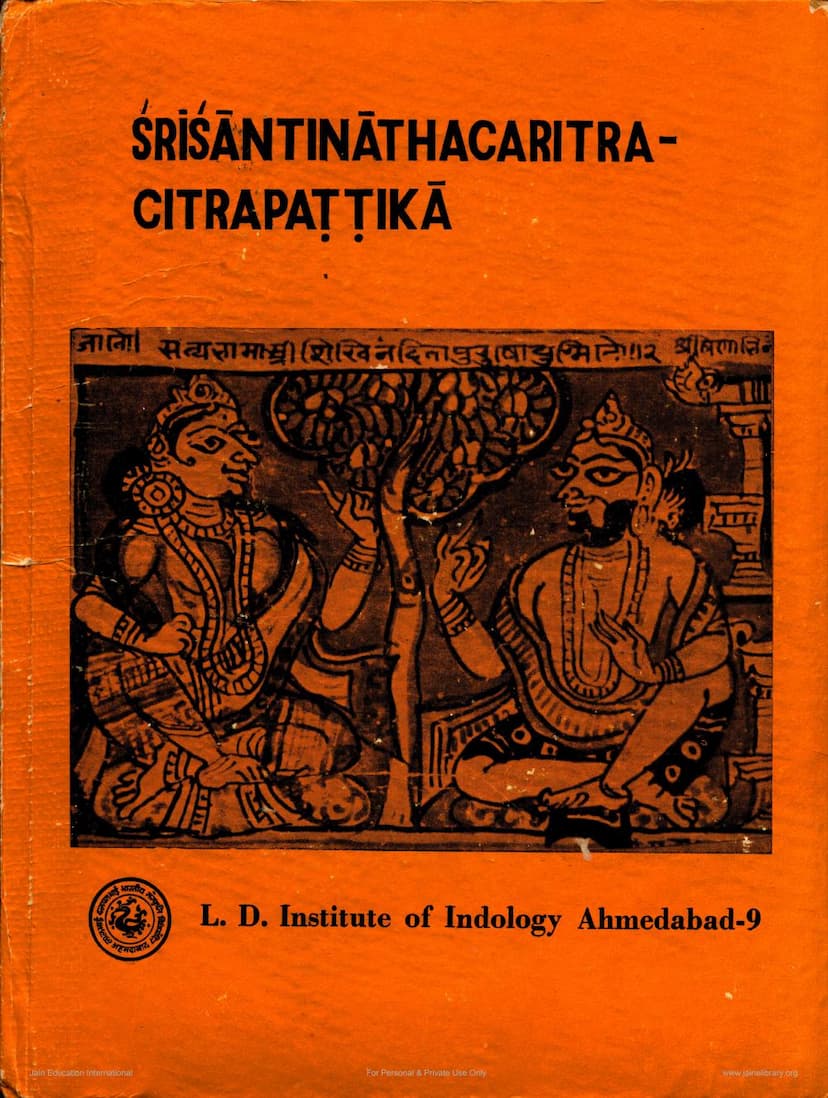Shantinath Charitra Chitra Pattika
Added to library: September 2, 2025

Summary
The document "Shantinath Charitra Chitra Pattika" by Sheelchandravijay, published by L. D. Institute of Indology Ahmedabad, is a scholarly work that presents and analyzes a set of 33 circa 700-year-old wooden panels (Chitra Pattika) depicting the life story of the 16th Jain Tirthankara, Lord Shantinath.
Here's a comprehensive summary of the text, drawing from the provided pages:
Overall Purpose and Content: The book is dedicated to illuminating the rich artistic and narrative heritage of Jainism, specifically through the life of Lord Shantinath as depicted on these ancient wooden panels. The author, Muni Sheelchandravijay, aims to provide a detailed explanation of each painting, an analysis of its artistic merit, and a coherent presentation of the life story narrated through these visuals.
Structure of the Book (as outlined by the publisher and author):
- Introduction/Preface (By General Editors and Author): The publication is welcomed with joy by the L. D. Institute of Indology. Muni Sheelchandravijay's work is praised for bringing the visual richness of these panels to light. The author expresses his happiness in presenting the research-based study of these ancient panels that depict Lord Shantinath's life cycle.
- Section 1: The Independent Existence of Jain Painting Style: The author dedicates the first section to establishing the distinct identity and artistic characteristics of Jain painting, presenting arguments and evidence to support this claim. This section likely delves into the stylistic elements that differentiate Jain art.
- Section 2: Introduction to the Manuscript and its Commentary: This section focuses on the specific palm-leaf manuscript that these wooden panels are associated with. It identifies the manuscript as the Shravak dharma prakaran vritti (a commentary on Jain layman's conduct) by Shri Lakshmitilakopadhyaya, composed in V.S. 1317 (1260-1261 CE) in Jalor. The manuscript is noted to be intimately connected with Jalor, where Lakshmitilakopadhyaya took initiation and received his Upadhyaya title. The commentary itself elaborates on Shantinath's life story in 1078 gathas (verses).
- The Wooden Panels (Chitra Pattika):
- These panels, approximately 700 years old, depict Shantinath's life, including his previous lives.
- They were created in Jalor, possibly on the Golden Mountain (Swarnagiri) where a temple of Shantinath existed.
- The panels were likely commissioned by the same patrons who commissioned the manuscript.
- A significant observation is that the artwork on the panels sometimes deviates from the narrative presented in Lakshmitilakopadhyaya's commentary. This discrepancy is attributed to possible reasons like the artist not receiving direct guidance from Lakshmitilakopadhyaya after he left Jalor, or a misunderstanding of his instructions.
- Section 3: Detailed Description and Analysis of Each Painting: The author provides an in-depth explanation of the events depicted in each of the 33 paintings, offering a critical appreciation of their artistic qualities.
- Section 4: Presentation of the Paintings: This section comprises the actual reproduction of the 33 paintings, with 8 in color and the rest in black and white.
Key Themes and Arguments:
- The Distinctiveness of Jain Painting Style: Muni Sheelchandravijay argues strongly for recognizing a unique "Jain style" in painting, despite debates among art historians who have proposed names like "Gujarat Style" or "Western Indian Style." He contends that the religious and doctrinal underpinnings of Jainism, the guidance of Jain Acharyas, and the specific artistic conventions developed within the Jain tradition justify this classification.
- The Intertwined Nature of Art and Narrative in Jainism: The book emphasizes how Jain art, particularly the miniature paintings on manuscripts and panels, serves to visually narrate religious stories and teachings, making them accessible and engaging.
- The Life of Lord Shantinath: The narrative focuses on the 16th Tirthankara, Shantinath, highlighting his journey through various lifetimes leading up to his attainment of liberation. The book emphasizes that becoming a great soul like a Tirthankara is a result of cumulative efforts across many lives, not just one.
- Historical and Artistic Context: The work places the panels within their historical context, discussing their creation in Jalor, their connection to the Shravak dharma prakaran vritti, and the potential influences and deviations in the artistic execution. It also touches upon the evolution of painting styles from palm-leaf manuscripts to paper.
- Detailed Visual Analysis: The author meticulously describes the iconography, compositions, attire, and stylistic features of the figures and scenes in each painting. He notes specific artistic choices, such as the depiction of eyes, facial features, clothing details, the use of color, and the portrayal of emotions. The technical aspects of painting, including the pigments used and the preparation of the surface, are also discussed.
- The Significance of the Panels: The publication is considered significant as it is the first time these specific panels are being published. It aims to contribute to the understanding of Jain art history and the lives of the Tirthankaras.
Acknowledgements: The author and publisher express gratitude to various individuals and committees for their support, including Muni Shri Shilchandra Vijayji, the publication committee of Barasutra Publication Committee in Surat, Shri Sobhanchand Nanabhai Lakdawala, and Shri Pravinchandra Rupchand Zaveri.
Overall Impression: "Shantinath Charitra Chitra Pattika" is a scholarly and deeply researched work that serves as a vital resource for understanding Jain art, history, and religious narratives. It combines textual analysis with a thorough visual examination of rare and significant artifacts, contributing significantly to the field of Indian art history.